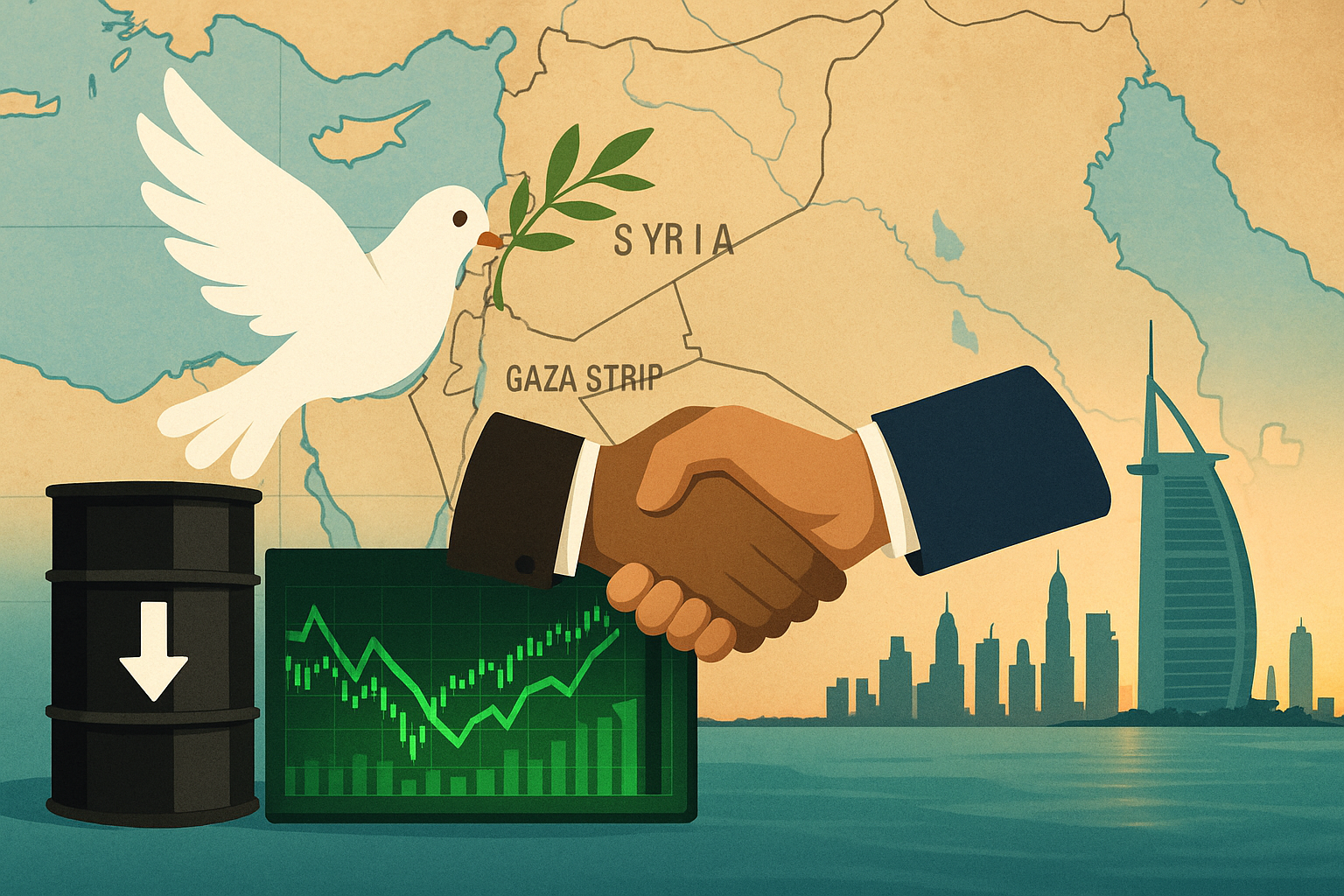“War Is Over,” Trump Says on Gaza Ceasefire, Markets Rally, Middle East Poised for Reset
By Tredu.com • 10/13/2025
Tredu

Trump Declares Gaza War Over, A Ceasefire Enters Force
On October 12, 2025, U.S. President Donald Trump publicly declared that “the war is over” in Gaza, following news of an agreement between Israel and Hamas under a Trump-brokered peace plan. The ceasefire, already holding into its third day, includes the release of Israeli hostages and Palestinian prisoners, and steps for Israel’s pullback.
This moment marks a turning point, though “the war is over” is still conditional: it depends on compliance, future phases of the deal, and stabilization on the ground.
Markets Exhale: Risk Premium Slips, Oil Eases, Gulf Shares Climb
Oil & Energy Markets
With the immediate specter of regional escalation fading, oil prices eased as risk premia retreated. Brent crude and WTI both dropped modestly. A pullback in geopolitical anxiety gives room for focus on supply fundamentals again.
However, trade tensions, especially between the U.S. and China, loomed as a counterforce. Some analysts tied last week’s price volatility to a mix of Gaza de-escalation and rising trade risk.
Gulf & Middle Eastern Equities
Gulf markets rallied in response to easing tensions and hopes for capital inflows. Saudi Arabia’s benchmark index and other Gulf stocks gained, buoyed by expectations of renewed investor confidence. (turn0search8)
Israel: Rebuilding the Economic Narrative
Israel’s economy has faced major strain during the conflict. A lasting ceasefire may open the possibility for recovery, reconstruction efforts, and restoration of investor confidence. Reuters commentary suggests that while the “truce dividend” is uncertain, the ceasefire helps buffer deeper economic cracks.
Key variables for Israel will include infrastructure rebuilding, restoring supply chains (especially with Gaza’s border shutdowns), and managing deficits and debt accumulated during wartime.
Regional & Strategic Implications
Political Rebalancing & Governance
The ceasefire paves the way for new governance models in Gaza. The Palestinian Authority is reportedly willing to assist in stabilizing postwar Gaza under transitional oversight.
Trump’s plan includes a 20-point peace roadmap and offers for a multinational stabilization force to secure demilitarization and reconstruction.
But challenges abound: Hamas may resist disarmament, local security vacuums risk chaos, and regional actors (Egypt, Jordan, Iran) may vie for influence over Gaza’s future.
Oil & Geopolitics
For oil producers and exporters, a calmer Middle East reduces the risk of supply shocks due to conflict. That said, many regional economies rely on oil export revenues, which could benefit from improved global demand sentiment.
Still, broader geopolitical tensions, like trade wars or shipping lane disruptions (e.g., Red Sea, Suez, Houthi activity), remain tail risks.
Capital Flow & Investment
Risk-premium compression may prompt capital migration back into Middle Eastern markets and infrastructure plays (reconstruction contracts, energy, port development).
Israel could become an investment destination again, especially in sectors tied to rebuilding: construction, defense, telecom, water, and Gaza border trade.
Risks & Caveats: Not a Peace That Lasts Yet
- Fragile Ceasefire: The agreement is in phases. Any violation or resumption of hostilities could reverse market gains.
- Security Vacuum: Without a capable stabilization force or strong local governance, disorder or insurgency could emerge.
- Political Pushback: Hardline factions in Israel, Gaza, or nearby states may resist concessions or oversight.
- Global Macros Still Loom: Inflation, central bank policies, China-U.S. tensions, and energy supply dynamics remain potent stressors.
- Time Lag on Rebuild: Reconstruction is capital-intensive and time-consuming; benefits won’t be immediate.
What to Monitor Next
- Hostage/prisoner exchanges & compliance: Whether Israel and Hamas fully adhere to deal terms.
- Security incidents & ceasefire breaches: Early signs of relapse.
- Reconstruction contracts & infrastructure pledges: Companies that win these may lead postwar upside.
- Regional diplomacy & alliances: Positions from Egypt, Jordan, UAE, Iran.
- Oil & supply signals: Watch OPEC+ decisions, inventory, global demand.
- Equity flows & credit spreads in Israel/Middle East: Are investors returning?
Final Word
By declaring the Gaza war over, Trump’s statement and the new ceasefire have already triggered market relief, easing oil’s risk premium and spurring gains in Gulf equities. The region now enters a fragile transition toward reconstruction, governance reshaping, and reopening of economic flows. But while the ceasefire may represent a turning point, real recovery depends on stable security, political will, and sustained capital, a process that’s far from guaranteed.
Core theme restated: The Gaza war’s end declaration is setting off market rallies and a regional reset, but its permanence hinges on peace enforcement, reconstruction, and navigating deep political fault-lines.

How to Trade Like a Pro
Unlock the secrets of professional trading with our comprehensive guide. Discover proven strategies, risk management techniques, and market insights that will help you navigate the financial markets confidently and successfully.


